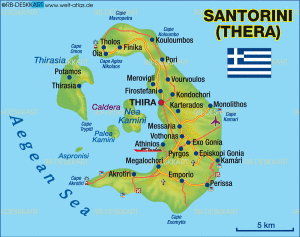Stronghyle
Santorini *
 Santorini, earlier known as Thera, is claimed by tradition to have received its name from Theras, a 9th century BC invader. It is the most southerly member of the Cyclades group of islands in the Aegean Sea. It is named after St. Irene of Thessaloniki. In ancient times it was known as Calliste (Most Beautiful) and Stronghyle. One source states that for a short period in the 16th century a Jew named Nazi (sic) owned Thera. A potted history of the island was compiled by Professor Christos Doumas(c).
Santorini, earlier known as Thera, is claimed by tradition to have received its name from Theras, a 9th century BC invader. It is the most southerly member of the Cyclades group of islands in the Aegean Sea. It is named after St. Irene of Thessaloniki. In ancient times it was known as Calliste (Most Beautiful) and Stronghyle. One source states that for a short period in the 16th century a Jew named Nazi (sic) owned Thera. A potted history of the island was compiled by Professor Christos Doumas(c).
Many writers over the past century have supported the idea that Atlantis was a Minoan society that was destroyed when Thera erupted violently in the second millennium BC. This is discussed more fully under Thera.
The archaeological site near the village of Akrotiri on the south of the island was closed nearly seven years ago after a ceiling collapsed killing one tourist and injuring six others. Now the site is due to open again in April 2012(a) ironically just as evidence is mounting of increased volcanic activity in the Santorini caldera(b).
Rather unexpectedly, I came across an article about a link between Santorini and vampires by Paul Devereux, not surprisingly in the Fortean Times of April 2013.
May 1st 2019 saw the opening of a new museum on Santorini, called The Lost Atlantis Experience.(d)
Santorini is also the home of Atlantis Books, which has been described as “one of Europe’s most enchanting bookstores” and has now become a tourist attraction in its own right.(e)
(b) https://greece.greekreporter.com/2012/03/13/volcanic-island-of-santorini-shows-activity/
(c) Notebook (archive.org) *
(d) https://www.atlantis-scout.de/atlantis_newsl_archive.htm
(e) https://www.nytimes.com/2019/10/27/books/atlantis-books-bookstore-santorini.html
